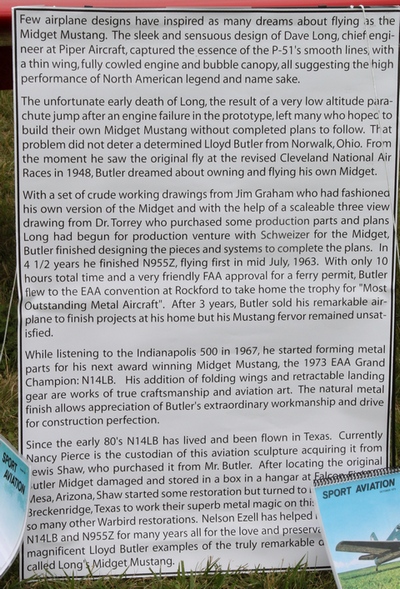














THE MIDGET MUSTANG-HOMEBUILT POCKET ROCKET
By WILLIE BODENSTEIN
Celebrating its 66th anniversary the Midget Mustang designed in 1948 by David Long then the Chief Engineer at Piper the Midget Mustang is probably one of the most enduring homebuilt designs ever.


Although designed as a racer Long had envisaged full scale production of the Midget as a post WWII sport plane and before his untimely death in 1950 in an engine failure crash had made arrangements with Schweizer Aircraft to start production. Sadly the market never developed partly because of the large number of surplus WWII aircraft available at bargain prices and partly due to depressed state of the economy. The Midget did attract attention from the homebuilders' movement that was then still in its infancy but orders were still slow and full scale production not feasible.



As a true high performance aerobatic sport plane with a flight load of 6g the Midget has few equals as speedy cross-country traveller. More than 400 Midget Mustangs have been built around the world and Long's 1948 design has acquired the reputation as being one of the best sport planes ever and had stood the test of time and now, sixty five years wherever it is parked or visiting the Midget will always drew a crowd of admirers. Over the years there have been four Midget Grand Champion's at Oshkosh, no mean feat as the title is hotly contested. Midget owners and pilots are understandably biased and so it's no surprise that without exception they would not trade their pride and joy for any other aircraft, all praising it's good looks, fighter like performance and excellent handling that today still makes it just a desirable an aircraft as it was just after WWII.

Midget Mustang Specifications (All figures at gross weight):
Performance with Continental & Lycoming engines
O-200 O-320
100 H.P. 160 H.P.
TOP SPEED (SEA LEVEL)
202 mph 230 mph
CRUISE SPEED (true airspeed, 75% power @ 8000 ft.)
175 mph 215 mph
NEVER EXCEED SPEED (indicated airspeed)
230 mph 230 mph
RANGE @ 75% POWER (standard 15 gal.)
435 miles 400 miles
RATE OF CLIMB
1500 fpm 2500 fpm
SERVICE CEILING
17,000 ft 20,000 ft
STALL SPEED (clean)
60 mph 62 mph
STALL SPEED (full flap)
57 mph 57 mph
TAKE OFF DISTANCE
570 ft 470 ft
LANDING DISTANCE
680 ft 680 ft
ROLL RATE
2000/sec 2000/sec
Performance numbers will vary depending on workmanship, propeller, and fairing installations.

Although designed as a racer Long had envisaged full scale production of the Midget as a post WWII sport plane and before his untimely death in 1950 in an engine failure crash had made arrangements with Schweizer Aircraft to start production. Sadly the market never developed partly because of the large number of surplus WWII aircraft available at bargain prices and partly due to depressed state of the economy. The Midget did attract attention from the homebuilders' movement that was then still in its infancy but orders were still slow and full scale production not feasible.


As a true high performance aerobatic sport plane with a flight load of 6g the Midget has few equals as speedy cross-country traveller. More than 400 Midget Mustangs have been built around the world and Long's 1948 design has acquired the reputation as being one of the best sport planes ever and had stood the test of time and now, sixty five years wherever it is parked or visiting the Midget will always drew a crowd of admirers. Over the years there have been four Midget Grand Champion's at Oshkosh, no mean feat as the title is hotly contested. Midget owners and pilots are understandably biased and so it's no surprise that without exception they would not trade their pride and joy for any other aircraft, all praising it's good looks, fighter like performance and excellent handling that today still makes it just a desirable an aircraft as it was just after WWII.

Midget Mustang Specifications (All figures at gross weight):
Performance with Continental & Lycoming engines
O-200 O-320
100 H.P. 160 H.P.
TOP SPEED (SEA LEVEL)
202 mph 230 mph
CRUISE SPEED (true airspeed, 75% power @ 8000 ft.)
175 mph 215 mph
NEVER EXCEED SPEED (indicated airspeed)
230 mph 230 mph
RANGE @ 75% POWER (standard 15 gal.)
435 miles 400 miles
RATE OF CLIMB
1500 fpm 2500 fpm
SERVICE CEILING
17,000 ft 20,000 ft
STALL SPEED (clean)
60 mph 62 mph
STALL SPEED (full flap)
57 mph 57 mph
TAKE OFF DISTANCE
570 ft 470 ft
LANDING DISTANCE
680 ft 680 ft
ROLL RATE
2000/sec 2000/sec
Performance numbers will vary depending on workmanship, propeller, and fairing installations.
 |
 |
 Copyright © 2024 Pilot's Post PTY Ltd
The information, views and opinions by the authors contributing to Pilotís Post are not necessarily those of the editor or other writers at Pilotís Post.
Copyright © 2024 Pilot's Post PTY Ltd
The information, views and opinions by the authors contributing to Pilotís Post are not necessarily those of the editor or other writers at Pilotís Post.